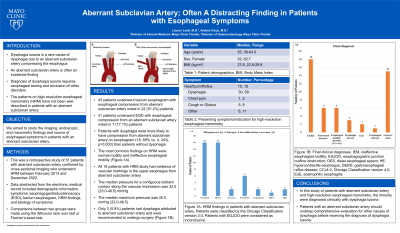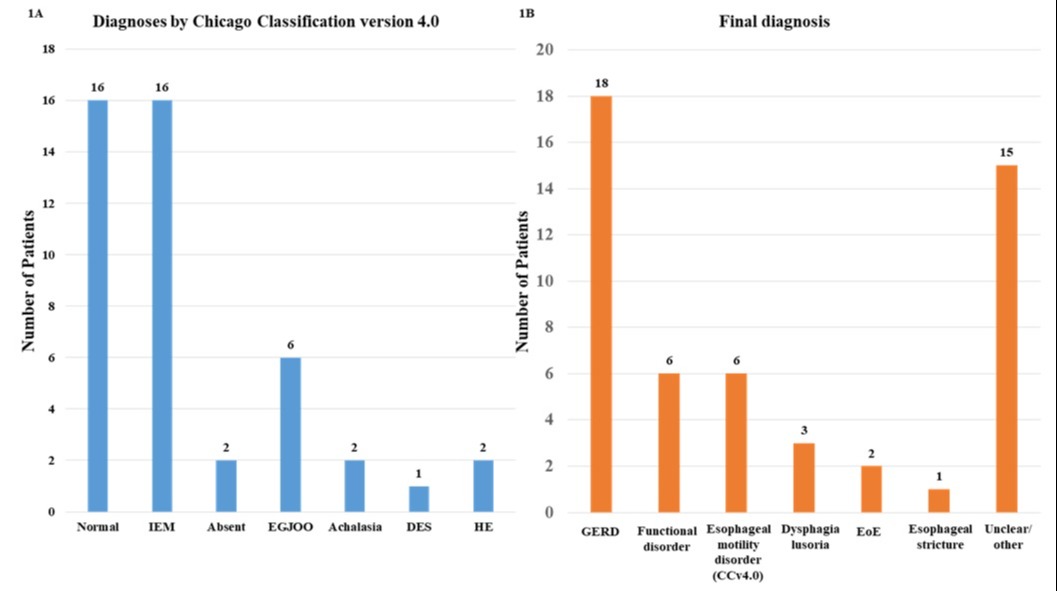Monday Poster Session
Category: Esophagus
P1847 - Aberrant Subclavian Artery: Often a Distracting Finding in Patients With Esophageal Symptoms
Monday, October 23, 2023
10:30 AM - 4:15 PM PT
Location: Exhibit Hall

Has Audio

Lauren Loeb, MD
Mayo Clinic Florida
Jacksonville, FL
Presenting Author(s)
Lauren Loeb, MD, Andree Koop, MD
Mayo Clinic Florida, Jacksonville, FL
Introduction: Dysphagia lusoria is a rare cause of dysphagia due to an aberrant subclavian artery compressing the esophagus. An aberrant subclavian artery is often an incidental finding and the diagnosis of dysphagia lusoria is confirmed based on symptoms, esophageal testing, and exclusion of other disorders. The patterns on high-resolution esophageal manometry (HRM) have not been well-described in patients with an aberrant subclavian artery. We aimed to study the imaging, endoscopic, and manometry findings and source of esophageal symptoms in patients with an aberrant subclavian artery.
Methods: This was a retrospective study of 51 patients with aberrant subclavian artery confirmed by cross-sectional imaging who underwent high-resolution esophageal manometry between February 2013 and December 2022. Abstracted data included demographic information, symptoms, esophagogastroduodenoscopy (EGD), barium esophagram, and HRM findings, and etiology of symptoms. Comparisons between two groups were made using the Wilcoxon rank sum test or Fischer’s exact test.
Results: Patient demographics and presenting symptoms are listed in Table 1. 43 patients underwent barium esophagram and 41 patients EGD. There was esophageal compression from aberrant subclavian artery in 7 (17.1%) patients on EGD and 22 (51.2%) patients on esophagram. Patients with dysphagia were more likely to have compression from aberrant subclavian artery on esophagram (18, 69% vs. 4, 24%, p=0.003) than patients without dysphagia. The most common findings on HRM were normal motility and ineffective esophageal motility (Figure 1A). All 18 patients with HRM study available for review had evidence of vascular markings in the upper esophagus from aberrant subclavian artery. The median pressure for a contiguous isobaric contour along the vascular impression was 32.5 (23.0-46.5) mmHg and the median maximum pressure was 45.0 mmHg (23.0-46.5). Only 3 (5.9%) patients had dysphagia attributed to aberrant subclavian artery and were recommended to undergo surgery (Figure 1B).
Discussion: In this study of patients with aberrant subclavian artery and high-resolution esophageal manometry, the minority were diagnosed with dysphagia lusoria. Patients with an aberrant subclavian artery should undergo comprehensive evaluation for other causes of dysphagia before receiving the diagnosis of dysphagia lusoria.

Disclosures:
Lauren Loeb, MD, Andree Koop, MD. P1847 - Aberrant Subclavian Artery: Often a Distracting Finding in Patients With Esophageal Symptoms, ACG 2023 Annual Scientific Meeting Abstracts. Vancouver, BC, Canada: American College of Gastroenterology.
Mayo Clinic Florida, Jacksonville, FL
Introduction: Dysphagia lusoria is a rare cause of dysphagia due to an aberrant subclavian artery compressing the esophagus. An aberrant subclavian artery is often an incidental finding and the diagnosis of dysphagia lusoria is confirmed based on symptoms, esophageal testing, and exclusion of other disorders. The patterns on high-resolution esophageal manometry (HRM) have not been well-described in patients with an aberrant subclavian artery. We aimed to study the imaging, endoscopic, and manometry findings and source of esophageal symptoms in patients with an aberrant subclavian artery.
Methods: This was a retrospective study of 51 patients with aberrant subclavian artery confirmed by cross-sectional imaging who underwent high-resolution esophageal manometry between February 2013 and December 2022. Abstracted data included demographic information, symptoms, esophagogastroduodenoscopy (EGD), barium esophagram, and HRM findings, and etiology of symptoms. Comparisons between two groups were made using the Wilcoxon rank sum test or Fischer’s exact test.
Results: Patient demographics and presenting symptoms are listed in Table 1. 43 patients underwent barium esophagram and 41 patients EGD. There was esophageal compression from aberrant subclavian artery in 7 (17.1%) patients on EGD and 22 (51.2%) patients on esophagram. Patients with dysphagia were more likely to have compression from aberrant subclavian artery on esophagram (18, 69% vs. 4, 24%, p=0.003) than patients without dysphagia. The most common findings on HRM were normal motility and ineffective esophageal motility (Figure 1A). All 18 patients with HRM study available for review had evidence of vascular markings in the upper esophagus from aberrant subclavian artery. The median pressure for a contiguous isobaric contour along the vascular impression was 32.5 (23.0-46.5) mmHg and the median maximum pressure was 45.0 mmHg (23.0-46.5). Only 3 (5.9%) patients had dysphagia attributed to aberrant subclavian artery and were recommended to undergo surgery (Figure 1B).
Discussion: In this study of patients with aberrant subclavian artery and high-resolution esophageal manometry, the minority were diagnosed with dysphagia lusoria. Patients with an aberrant subclavian artery should undergo comprehensive evaluation for other causes of dysphagia before receiving the diagnosis of dysphagia lusoria.

Figure: Figure 1: Figure 1A demonstrates findings on high-resolution esophageal manometry in patients with aberrant subclavian artery. Patients were classified by the Chicago Classification version 4.0. Patients with EGJOO were considered as inconclusive. Figure 1B illustrates the final clinical diagnosis of the patients in this cohort. IEM, ineffective esophageal motility; EGJOO, esophagogastric junction outflow obstruction; DES, distal esophageal spasm; HE, hypercontractile esophagus; GERD, gastroesophageal reflux disease; CCv4.0, Chicago Classification version 4.0; EoE, eosinophilic esophagitis
Disclosures:
Lauren Loeb indicated no relevant financial relationships.
Andree Koop indicated no relevant financial relationships.
Lauren Loeb, MD, Andree Koop, MD. P1847 - Aberrant Subclavian Artery: Often a Distracting Finding in Patients With Esophageal Symptoms, ACG 2023 Annual Scientific Meeting Abstracts. Vancouver, BC, Canada: American College of Gastroenterology.
